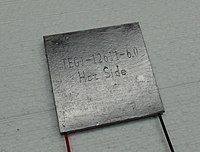
Photo from wikipedia
DOI: 10.1002/aenm.202000627 of energy collection.[1–5] However, ambient mechanical energy is characterized as having a wide range of operating frequencies, low amplitudes, randomness, and irregularity.[6–8] This sets a barrier for the… Click to show full abstract
DOI: 10.1002/aenm.202000627 of energy collection.[1–5] However, ambient mechanical energy is characterized as having a wide range of operating frequencies, low amplitudes, randomness, and irregularity.[6–8] This sets a barrier for the mechanical energy collection for electromagnetic generators with weak performance in power generation at low frequencies.[9,10] In 2012, triboelectric nanogenerators (TENGs) with high power density, high energy conversion efficiency, and low costs were proposed by Wang's group,[11] which aroused comprehensive attention on the aspect of energy harvesting research.[12–17] Based on the coupling of triboelectrification effect and electrostatic induction, TENGs show excellent characteristics at low frequency and low amplitude, so they can convert ambient mechanical energy into electrical energy efficiently.[18–24] Researchers have investigated harvesting energy from the ocean, human motion, and vibration and wind in the environment.[25–28] Depending on its operating principle, the output characteristics of TENGs, especially the current, are determined by the external excitation.[29–32] However, the randomness and irregularity of energy from the environment results in an output performance of TENGs that is usually irregular and uncontrollable.[33,34] This has become one of the key problems restricting their applications. In the paper, the research philosophy of a mechanical regulation triboelectric nanogenerator (MR-TENG) with controllable output performance for harvesting random energy is proposed for the first time. Through the combination of the energy storage structure and the control switch structure, the controllable output of TENG under random excitation is achieved. The MR-TENG is made up of five main components: transmission unit, switch structure, generator unit which includes stator and rotor, flywheel, and shell. The structural transmission unit transfers random linear or rocking motions in the environment to the flywheel. The rotor of the generator unit fixed on the flywheel includes six flexible blades and a thin-walled cylinder. The stator of the generator unit includes a shell with 12 copper electrodes pasted equidistant on the inner wall of this shell. The rotor and stator cooperate to convert rotational kinetic Recycling of random mechanical energy in the environment has become an important research hotspot. The triboelectric nanogenerators (TENGs) were invented to harvest energy, and have been widely applied due to their simple structure, small size, and low cost. This paper reports a mechanical regulation triboelectric nanogenerator (MR-TENG) for the first time with controllable output performance used to harvest random or irregular energy in the environment. It comprises a transmission unit, switch structure, generator unit, flywheel, and shell. Random linear motion or rocking motion is transferred via the transmission unit to the flywheel. The rotor of the generator unit fixed on the flywheel and the stator of the generator unit fixed on the shell combine. By controlling the storage and release of energy in the flywheel, the switch structure assists the flywheel to convert random or irregular energy into a controllable and stable energy output. The MR-TENG can generate an open-circuit voltage of 350 V, a shortcircuit current of 12 μA, a transfer charge of 130 nC, and a peak power of 2.52 mW. Furthermore, a thermometer and more than 300 light emitting diodes (LEDs) are separately powered by this MR-TENG in simulated water waves, demonstrating its potential application in water wave energy harvesting.
Journal Title: Advanced Energy Materials
Year Published: 2020
Link to full text (if available)
Share on Social Media: Sign Up to like & get
recommendations!